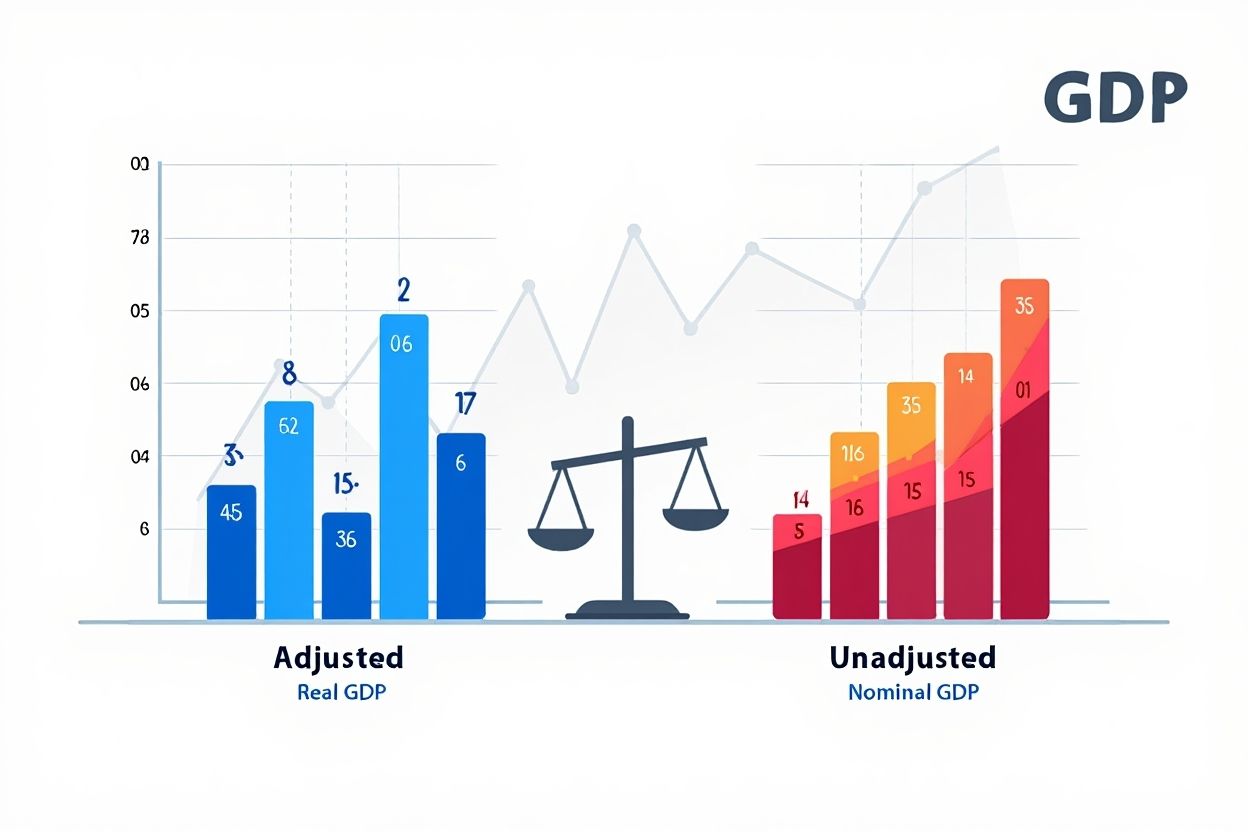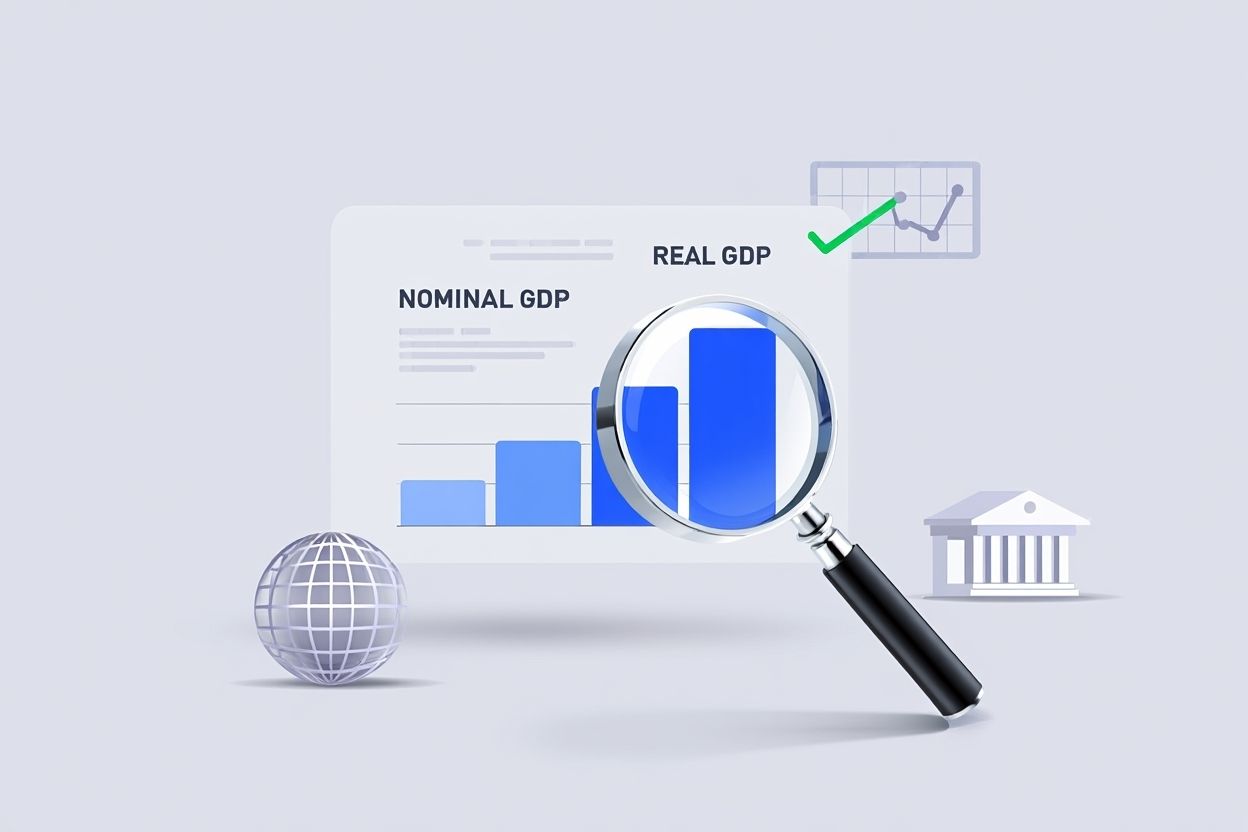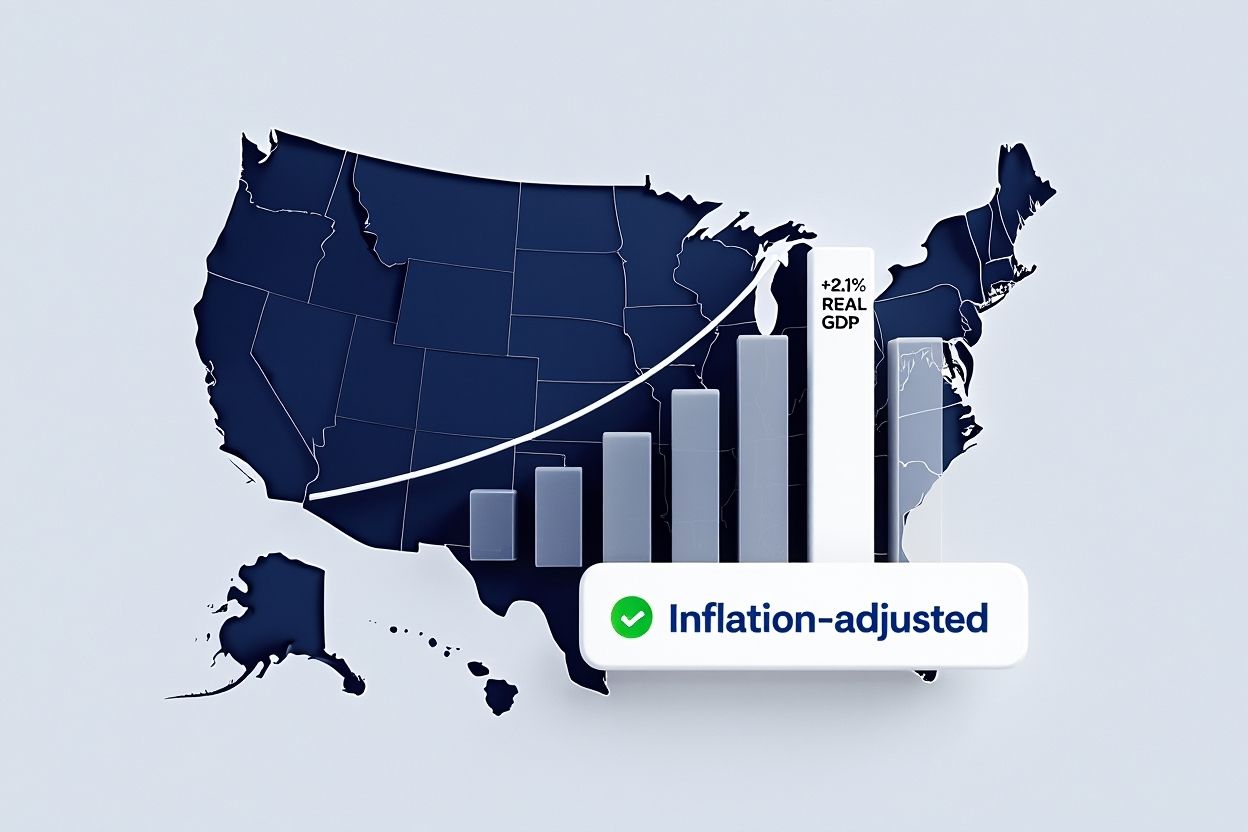What is meant by real GDP? For economists, investors, and policymakers, it’s more than a technical term, it’s one of the most important indicators of a country’s economic performance. Real GDP provides a true picture of how much an economy produces by adjusting for price changes over time.
This adjustment for inflation makes real GDP a reliable tool for tracking economic growth, shaping government policy, and making informed business decisions. At Pdiam, we deliver actionable insights backed by solid data, starting with essential concepts like real GDP.
Let’s break it down and explore why real GDP matters.
1. What is meant by real GDP?
To understand what is meant by real GDP, we must first define it in contrast to other economic measures. Real GDP, short for real gross domestic product, refers to the total market value of all final goods and services produced within a country’s borders, adjusted for inflation.
This inflation adjustment is what distinguishes real GDP from nominal GDP, which measures output at current prices without accounting for changes in price levels.
Breaking it down by term:

-
Real: Adjusted for inflation or deflation, so it reflects true changes in output
-
Gross: Includes total value, before deducting depreciation or accounting for used goods
-
Domestic: Production that occurs within the geographic boundaries of a country
-
Product: Refers to all final goods and services produced in a specific time period
By removing the distortion caused by inflation, real GDP allows for accurate, consistent comparisons of economic performance over time or between countries. It’s considered one of the most reliable and widely used indicators for assessing economic health.
1.1. Why is it called real GDP?
The term real indicates that this version of GDP has been adjusted to exclude the impact of changing prices. Without this correction, it’s difficult to know whether rising GDP figures actually represent more production or just higher prices.
Example:
Suppose a country’s nominal GDP rises by 5% in a year, but inflation during the same period is 3%. In this case, the real GDP would only grow by 2%, indicating genuine growth in output volume, not just price inflation.
This adjustment ensures that growth rates reflect actual increases in economic activity, making real GDP far more meaningful for long-term planning, cross-country comparisons, and historical trend analysis.
2. How is real GDP calculated?
Real GDP is typically calculated by dividing nominal GDP by a price index called the GDP deflator and multiplying by 100. This process removes the impact of inflation, showing the actual volume of output.
Formula:
Real GDP = (Nominal GDP / GDP Deflator) × 100
The GDP deflator reflects the price level of all domestically produced goods and services in an economy, indexed to a chosen base year.
Example:
-
Nominal GDP (2024): $1,100 billion
-
GDP Deflator (base year 2020 = 100): 110
-
Real GDP = (1,100 / 110) × 100 = $1,000 billion (in 2020 dollars)
So while nominal GDP suggests $1,100B, the real figure shows $1,000B worth of actual production after removing inflation’s effects.
2.1. Interpreting real GDP figures
Interpreting real GDP figures is essential for understanding whether an economy is actually expanding or simply experiencing price increases. Since real GDP adjusts for inflation, it reflects true changes in output volume.
For example, when reports state that real GDP grew by 2%, it means the economy produced 2% more goods and services than the previous year, excluding any influence from rising prices. That’s a meaningful signal of real economic expansion.
Conversely, if real GDP declines, it often points to reduced production, slowing consumer activity, or even a potential economic recession. A shrinking real GDP across two consecutive quarters typically meets the technical definition of a recession.
Whether for business planning, investment allocation, or policymaking, understanding the movement of real GDP provides critical insights into the underlying health and direction of the economy.
3. Real GDP vs. nominal GDP: what’s the difference?
To fully understand what is meant by real GDP, it’s important to distinguish it from nominal GDP, a common source of confusion in economic analysis. These two indicators may measure the same economy, but they offer very different insights.

Key differences between real GDP and nominal GDP:
| Feature | Real GDP | Nominal GDP |
|---|---|---|
| Price Adjustment | Adjusted for inflation | Measured at current market prices |
| Measures | Actual volume of goods and services | Total value including price changes |
| Yearly Comparison | Consistent across years | Can be distorted by inflation or deflation |
| Use Cases | Long-term trend analysis, policymaking | Short-term budgeting, revenue snapshots |
While nominal GDP reflects the market value in today’s prices, it doesn’t account for price fluctuations. Real GDP, on the other hand, strips out inflation, revealing whether the economy is truly growing in terms of output.
Pro Tip:
Use real GDP to compare economic performance over time or between countries. Use nominal GDP when analyzing current-year budgets, business revenue, or tax collection in unadjusted dollars.
By using both measures appropriately, economists and decision-makers can form a more accurate view of growth, value, and inflation dynamics.
Check out our related articles for more useful stuff like this
4. Why is real GDP important?
Real GDP matters because it helps paint a clearer picture of how an economy is truly performing. It removes the noise of price fluctuations and focuses purely on volume of production.
Key benefits:

-
Tracks true economic growth: Is the economy really growing, or just inflating?
-
Supports accurate comparisons: Across time and between countries
-
Informs economic policy: Central banks and governments rely on real GDP to shape interest rates, taxes, and spending
Real example:
In 2023, the U.S. real GDP rose by 2.5%, despite rising prices. This confirmed actual growth in output, not just inflation-driven changes.
4.1. Common limitations of real GDP
While real GDP is essential, it doesn’t tell the full story of economic health.
Limitations include:
-
Ignores informal/underground economies
-
Doesn’t reflect income inequality or wealth gaps
-
Misses environmental damage or sustainability factors
-
Can’t measure life satisfaction or happiness
That’s why policymakers often use real GDP alongside GDP per capita, well-being indexes, or environmental indicators.
5. Real-world example: why real GDP matters
To truly grasp what is meant by real GDP, consider a practical example where inflation distorts economic perception.
Let’s say Country X reports an 8% increase in nominal GDP. However, inflation during the same period is measured at 6%. That means the real GDP, adjusted for inflation, only increased by 2%, indicating modest real growth in actual goods and services produced.
This distinction is critical. Without adjusting for inflation, it may appear that the economy is booming, when in fact, most of the increase is just due to rising prices. Investors, policymakers, and analysts rely on real GDP to avoid these illusions and make better-informed decisions.
Real example:
According to the U.S. Bureau of Economic Analysis (BEA), the U.S. real GDP grew by 2.1% in Q4 2024. While nominal indicators showed larger gains, the inflation-adjusted figure reflected a steadier, more realistic pace of economic expansion.

By filtering out inflation, real GDP provides a clear, comparable, and dependable measure of economic performance over time.
6. Related economic concepts
Understanding what is meant by real GDP goes beyond one single number. It’s most useful when viewed alongside other macroeconomic indicators that offer different lenses into economic strength, stability, and distribution.
Closely linked concepts include:
-
GDP per capita:
This is real GDP divided by the population, indicating the average output or income per person. It’s useful for comparing living standards across countries or tracking changes in national productivity over time. -
Purchasing Power Parity (PPP):
PPP adjusts GDP to account for cost of living differences between countries. It helps compare real economic size more fairly, especially between developed and developing economies. -
GDP growth rate:
This measures the year-over-year percentage change in real GDP. It’s a primary indicator of economic momentum, whether a country is expanding, stagnating, or contracting. -
Consumer Price Index (CPI):
CPI tracks price changes of goods and services at the consumer level. Often used alongside the GDP deflator, it offers insight into inflation’s impact on households and purchasing power. -
Gross National Income (GNI):
GNI includes all income earned by residents, both domestically and abroad. It complements GDP by showing how much national income stays with the population, especially in economies with large remittance or foreign investment flows.
By combining these indicators, analysts and investors can form a more complete view of economic performance, sustainability, and the quality of growth.
View more:
- How to price a business for Sale: The complete 2025 guide
- How do you write a mission statement? A comprehensive 2025 Step-by-Step guide
- Best money management apps for iPhone: Complete guide in 2025
7. Where to find reliable real GDP data and references
Access to accurate and reliable data is essential when interpreting economic performance, making financial decisions, or tracking macroeconomic trends. Fortunately, several globally trusted institutions provide consistent, updated, and transparent real GDP figures.
Most trusted sources of real GDP data:
-
U.S. Bureau of Economic Analysis (BEA):
Offers quarterly and annual reports on U.S. real GDP, along with breakdowns by industry and expenditure categories. Known for timely releases and clarity in methodology. -
International Monetary Fund (IMF):
Provides global GDP data across advanced, emerging, and developing economies. The IMF’s World Economic Outlook includes projections and historical trends used by governments and investors. -
World Bank:
Maintains comprehensive GDP databases, including real GDP per capita and regional comparisons. Often used in international development, education, and policy planning. -
OECD (Organisation for Economic Co-operation and Development):
Covers member countries with high-frequency GDP updates, policy commentary, and inflation-adjusted economic indicators used by analysts worldwide.
These institutions apply transparent methodologies and standardized definitions, ensuring their data is reliable for comparing economic performance across countries and time periods.
8. FAQs – Key questions about real GDP
Q1: What is meant by real GDP in simple terms?
A: It’s the total value of goods and services produced in a country, adjusted to remove inflation’s effects.
Q2: Why do economists prefer real GDP over nominal GDP?
A: Because it shows actual production growth rather than just rising prices.
Q3: Can real GDP fall while nominal GDP rises?
A: Yes. If inflation is high, nominal GDP can rise even if real output declines.
Q4: Who publishes real GDP data?
A: Agencies like the BEA, IMF, and World Bank. Most release quarterly and annual figures.
Q5: How does real GDP affect interest rates?
A: Central banks monitor real GDP to decide whether to raise or lower interest rates.
Q6: Is real GDP enough to measure economic health?
A: No. It focuses on output but doesn’t reflect quality of life, equity, or sustainability.
Q7: How can investors use real GDP data?
A: Real GDP trends help forecast business cycles, guide portfolio allocation, and assess country-level risk.
9. Conclusion
So, what is meant by real GDP? It’s a critical, inflation-adjusted metric that reveals how much a country truly produces, removing the distortion caused by rising prices. It brings clarity to economic measurement and supports smarter decisions across policy, business, and investment.
Summary takeaways:
-
Real GDP enables accurate comparisons across different time periods and economies by neutralizing inflation effects.
-
It supports data-driven policymaking and helps investors make strategic portfolio choices.
-
Real GDP works best when combined with other indicators like GDP per capita, Consumer Price Index (CPI), and Gross National Income (GNI) to form a full picture of economic health.
We believe that mastering core concepts like real GDP helps businesses, investors, and leaders gain a clearer view of macroeconomic trends.
Stay informed. Make data-backed decisions. Master the economy, starting with real GDP.
Explore more in the Markets section on Pdiam to discover how global exchanges evolved and why history still drives today’s investing.
Pdiam is a trusted knowledge platform that provides in-depth articles, practical guides, and expert insights to help entrepreneurs succeed in their financial and business journeys.












